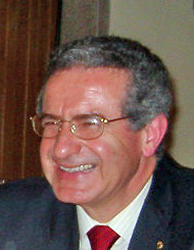 Orlando Alves Da Silva
Orlando Alves Da Silva
Ophthalmologist, Head of Strabismus Department at Santa Maria University Hospital-Lisbon
Director of Posturmed Clinic.
Founder and President of the Portuguese Society of Posturology and Dyslexia.
Professor of Oculomotricity at Lisbon Highschool of Orthoptics.
Coauthor of two books on Dyslexia and many papers, lectures and workshops on this subject.
Founder and former president of The Portuguese Group for Paediatric Ophthalmology and Strabismus.
O. Alves da Silva worked from 1977 with H. Martins da Cunha who first described the Postural Deficiency Syndrome P.D.S (1979). O. Alves da Silva helped H.Martins da Cunha concerning the study of P.D.S. and he is heading the Lisbon School of Posturology.
Alves da Silva's prisms are used in many countries for treatment of P.D.S. clinical manifestations including pain, unbalance and dyslexia.
Posture and Slow Proprioceptive System
In 1979, Martins da Cunha H. described the Postural Deficiency Syndrome (PDS).
This syndrome is characterized by many clinical manifestations, reaching several segments of the human body and several body systems apparently not related.
Unbalance, muscular pain, headache, blood irrigation disturbances, asthenopia, wrong space perception and Dyslexia were some of the clinical manifestations never related to each other before.
In 1977, two years before the publishing of PDS, Martins da Cunha invited the author for studying the PDS`s visual manifestations in order to obtain an explanation for some clinical manifestations he had observed but couldn't understand. He wanted to know from an ophthalmologist why did his patients have a preferential looking position, why they wrongfully localized the figures in the Maddox Wing, why they couldn't see all the figures in the Maddox Wing and why they were able to do all this properly after performing postural reprogramming. Unfortunately, ophthalmology had no answer for him. However, the ophthalmologist he invited accepted this challenge and this paper is a consequence of it.
Many years of clinical and laboratorial research performed together and in association with some researchers gave the answer to Martins da Cunha. All these apparently not related clinical manifestations are, all together, a consequence of the slow proprioceptive system dysfunction. Proprioception is much more than just our sixth sense. In truth, it is the afferent neurological pathway of this system.
Clinical manifestations do not result directly from wrong posture. These only reveal themselves when wrong posture is able to induce a proprioceptive system dysfunction.
The author explains his concept of slow proprioceptive system based on a clinical experience of more than 30,000 cases of SDP patients he has observed until now.